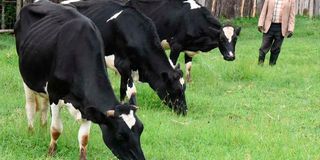Of Kenyan cows and Ugandan grass

What you need to know:
- In other words, though it might produce slightly less milk, the Ugandan cows are better put together. It is the full package. Their legs are straighter, I could see that, and stronger, he said.
We just returned from northern Uganda, where I stopped, among other places, at a clever small farm called Gulu Country Dairy. It was founded and is managed by an alternative-thinking veterinary doctor, Tonny Kidega.
He is an East Africanist, and a man of the world. We stood watching the machines milk the cows, then he pointed to a tall one: “That one is from your place, Kenya.” Being ignorant in matters to do with cows and milk, the only helpful thing I could do was grunt.
He noticed immediately that I was in need of an education, so he explained why that was important, and the difference between a Kenyan and Ugandan cow at the high end of the dairy business.
“The Kenyan cows are taller than the Ugandan ones. That is partly because there is a strong Kenyan philosophy to breed for high milk production,” he said.
“But as you can see, it is almost knock-kneed and has weaker legs. Compared to the Ugandan one, though it gives you more milk, it has a poorer quality of life, and generally is more likely to leave the farm dead.
“My approach, and the dominant Ugandan tendency, is to go for conformity,” he said.
In other words, though it might produce slightly less milk, the Ugandan cows are better put together. It is the full package. Their legs are straighter, I could see that, and stronger, he said.
They also live a better quality of life and are more likely to leave the farm alive.
Now that he had said it, I could see. Moderately shorter, the Ugandan cows had significantly more filled rumps than their Kenyan peers. Of the two, they clearly were the more likely to win a beauty pageant. The Kenyan ones, however, were definitely the ones that would make a hard-nosed farmer richer.
It was striking how the two countries’ approach to dairy cows mirrored aspects of their national characters. Kenya juices up its economy to far higher levels than Uganda does, and builds grander. As a result, it is more productive. Kenya also is more likely to trash and hollow out a national asset once its value has been milked. The Daniel arap Moi years, in particular, were a master class in how to gorge on national assets, then hollow them out.
Uganda doesn’t build too many grand things. They are smaller than Kenya’s and tend to be more elegant. Then they will be milked, and once they are done sucking it, will be allowed to stand as soulless glorified moments.
Kenya, then, is the place that builds a cathedral in record time. Then when the vultures go to work, they take down the roof, the walls, everything. Uganda will build a chapel at the same time. And when its hyenas set upon it, they will take down the roof, windows, doors, but they will leave the walls and altar standing.
Anyhow, I thought the conclusion of all this would be that Ugandan farmers shouldn’t import Kenyan breeds. “We need to import them to improve productivity, but the lesson we have learnt is that we need to import them when they are very young and raise them in the Uganda way,” Kidega said. “That way, we get the best of both worlds.”
Northern Uganda, helped ironically by the fact that the 20-year-old war against Joseph Kony’s Lord’s Resistance Army rebels allows nature to blossom and the land to fallow marvellously, is a grass-rich region.
That northern Uganda grass has piqued Kenyan interest because Kenya is sliding toward hay scarcity. It can snap up hundreds of tonnes of hay from northern Uganda alone every year. Progressive farmers emerging in South Sudan too are looking to the northern Uganda hay.
In the dry periods, many fires, some stretching to areas wider than a square kilometre, are started in the region, often for the less ambitious goal of driving wild rats into the paths of hunters.
If the folks could stop the burning and turn it into hay, a picture was painted of a “grass corridor” running between South Sudan and Kenya through northern Uganda, and creating hay millionaires along the way.
It would also have a regional security impact, as it would dampen some of the cross-border violence and criminality in the region related to dwindling pasture.
Until recently, this kind of big-picture regional thinking and geopolitical gaming was the domain of the foreign policy and national security in the capitals. It was not common in what, for lack of a better word, one could call the fringes. Yet there we were deep in northern Uganda, in a very East African conversation, about cows and grass.
It wasn’t over. Approaching Gulu town, we stopped at a town along the highway to buy snacks at a roadside market. We were told one of the women we bought stuff from spoke only Kiswahili. To understand how radical that is, imagine stopping in Isiolo, eastern Kenya, and being told a vendor in a local market speaks only French. Something intriguing is going on this east side of Mother Africa.




